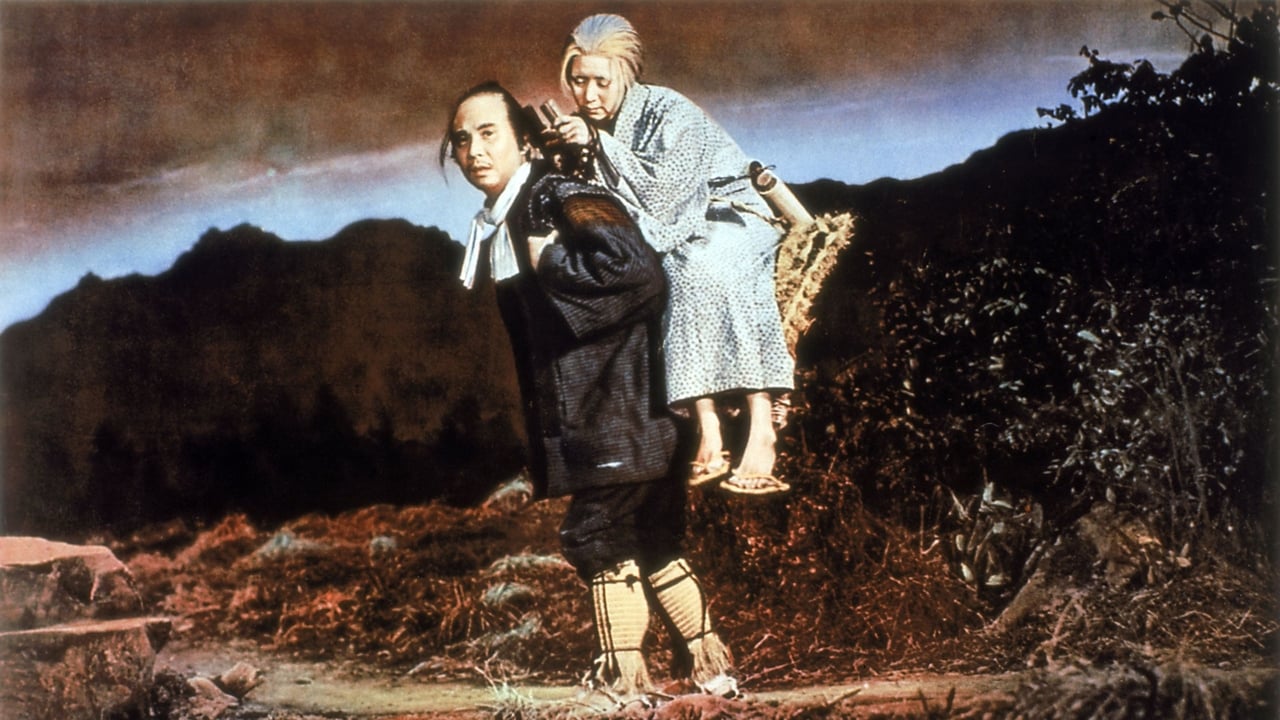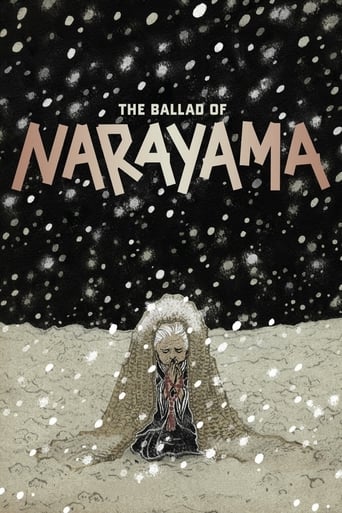

In Kabuki style, the film tells the story of a remote mountain village where the scarcity of food leads to a voluntary but socially-enforced policy in which relatives carry 70-year-old family members up Narayama mountain to die.Roger Ebert of the Chicago Sun-Times rated the film a maximum 4 stars, and added it to his Great Movies list in 2013, making it the final film he added to the list before his death. In a June 1961 review in The New York Times, A.H. Weiler called the film "an odd and colorful evocation of Japan's past that is only occasionally striking"; "It is stylized and occasionally graphic fare in the manner of the Kabuki Theatre, which is realistically staged, but decidedly strange to Western tastes." I have to respectfully disagree with Weiler. Perhaps at the time the film was strange to Western taste. I couldn't speak to that. But I find it quite refreshing, and really enjoy how they made it obvious that the story was told on a stage. Rather than hide the stag as American films do, this one embraces it, so you know you are really watching a story and it need not be any more than that. And yet, it is not just theater but a bigger experience.
... View MoreThe Ballad Of Narayama (aka: Narayam bushiko) is a film by Keisuke Kinoshita, whose directing career stretched over 40 years. In notable fashion it mixes kabuki style balladeer narration and musical accompaniment with a tragic story set around responsibilities of old age, rural hardship, family cruelty and the painful obligations brought by restrictive and conservative social convention. It's a consideration of that which is a characteristic of many films made before, and during, the golden age of Japanese cinema. In the hands of masters like Mizoguchi, for instance, such depictions frequently evolved into profound considerations of the female condition. (In fact star Kinuyo Tanaka, was a favourite of that master, having previously appeared in films like Sansho Dayu and Ugetsu Monogatari.) Narayama is of that old school: an often painful - this viewer for one will long remember the moment when the old woman knocks out her own teeth on the edge of a stone grinder - and frequently moving account of a society which denies dignity to the old but which, at least in one instance, is granted them anyway. Such a traditional style of storytelling all but vanished when a new wave of Japanese directors come to prominence in the following decade. As others have observed the biggest irony of the film is that grandmother Orin is probably the single most productive member of her immediate circle. Of her nearest relatives, as she herself says: "Tatsuhei and Kesakichi are useless" - seen thus, her looming absence is very much a tragedy on both a social, as well as a personal, level.Much of Narayama's power is drawn from its exquisite staging, an entirely successful recreation of a village environment and surrounding countryside done entirely in the studio. Except for the striking final shots, every part of the film is artificial, including the passing of time, even if emotions evoked thereby are not. Intense character interactions are sometimes emphasised in pools of light, while at another moment the set is lit in an ominous red; painted backcloths occasionally drop to provide transition between one scene and another, while actors end their parts in silhouette as the next action starts up behind them. Close ups are used sparingly, characters typically seen at a distance in their environment, again as on a stage. It is a process unique to this version of the tale, based on the folk story Dumping Grannies. It was one that, incidentally, was not copied over by Imamura in his, also critically successful, 1983 remake of Narayama with the result that that film arguably had a wider international appeal (it won top prize at Cannes).In a different tradition entirely, the artificiality and expressionism on display in the present version recall that of Kwaidan (1964) a colour horror film where even the sun and sky are painted in dramatic fashion - even though not with quite the intensity. The result of Narayama's very deliberate technique is to emphasise the narrative texture of events as well at the same time to place them firmly within a particularly nationalistic tradition of story telling. It's also a cumulative effect given abrupt contrast by the last scene of the film, which places events back in a modern context.In the film, moments of pathos and tragedy frequently counterbalance those of formality and ritual, and it's the tension between these two that gives the results power, and their Japanese flavour. This is most notable during the final trip to the mountain, one made by the despairing son carrying his grandmother upwards on his back. It's a long journey both for the principals as well as in actual screen time, as the passage occupies long and frequently silent minutes as they pass deliberately through the artificially crafted landscape. It's one that has been previously described, and its responsibilities circumscribed, by the precise instructions of village elders. But it speaks volumes too as far as the central relationship is concerned; heartbreaking as the mother refuses to communicate during her final hours, and as we see Tatsuhei torn between duty and natural familial feeling.As one might expect the performances in Narayama are uniformly excellent, although that of Tanaka ought to be singled out for especial praise. Her portrayal of Orin conveys sadness, warmth and self-sacrifice in equal, convincing measure. With her entirely honourable acceptance of her destiny, and blind faith in the reasoning behind it, she is as much a reflection of her society as she is criticism of it. Termed by her contemporaries the "33 devil teeth woman" for her unhelpfully intact dental work (a sign of her continuing, unwelcome food consumption), Orin never the less retains a defining put-upon dignity which remains intact for the duration of the film, even when she says nothing but droops sadly, carried to her fate on her son's back.A world away from the MTV editing techniques and CGI laden work of contemporary Hollywood product, some will find the essentially static nature of this film a challenge, and indeed for a introduction to classic Japanese cinema viewers would be better directed to the contemporary work of Kurosawa. Others will be pleased that such a relatively hard to see classic is at last available after some time out of circulation. The Ballad Of Narayama is a film whose formal beauty and human qualities impress even today.
... View MoreIn terms of movie making, Ballad of Narayama is not unlike shooting of a live play, with sets of distant mountains, stage lightning, and actors at a distance. There are however also close ups, where required, so that we know that we are watching a film rather than a live shooting of a play.Most effective is the narration of the story through a ballad, in the kabuki style. Very loosely, I suppose one can compare it with Cat Ballou, in the sense that at intervals, the ballad takes over in moving the story forward. But the music is obviously entirely different. In Narayama the desolate style of the kabuki singing and haunting mood of the Japanese lute add so much power to some of the heart wrenching scenes.The story is an allegory on the most fundamental of human tragedies, the insufficiency of resources. By tradition and custom, old people of the poor village are taken to the distant mountains of Narayama and left to die when they reach seventy. In this story which brings us right into close-up contact with a family, the old woman Orin's son had just lost a wife through accident and about to take a new one, a recently widowed woman from the next village. Meanwhile, his young son wants to marry. Both involve adding another mouth to be fed, in a year when harvest is particularly poor. But while the son and new daughter-in-law, in their love for Orin, want to delay taking her to Narayama, the callous grandson wants to get rid of the old grandmother as soon as possible.The old woman, in hope of easing her son's agony, always talks about going to Narayama cheerfully as if it's like the Elves going "into the west". Her enthusiasm may even spread to the audience, although her son knows exactly what it means and tries to hold back his anguished tears every time the subject is mentioned. When this finally comes, we see the son carrying Orin on his back, struggling up rugged mountain paths and begging his mother to speak to him one last time. Orin steadfastly refuses to say anything, knowing that any exchange would just make the parting that much more painful. At the ghostly desolate mountain top, he leaves her, among scattered skeletons of those who went before and preying carrion crows, and dashes sway in tears, running madly downhill, when snow starts to come down. And that's a good sign, because the soil will be better next year for a better crop. A most heart-wrenching scene.When we read about famines that kill millions, it's something that is in such a macro scale that it is beyond a personal experience. Watching Narayama, the audience sees how the village can only afford to eat pure white rice just once a year, during the Narayama Festival. We see how the next village is anxious to send over the widow to Orin's family as early as possible because she can start eating there. We see how the heartless grandson can only think of getting rid of the grandmother to make room for his own wife. We see how eating is the biggest ritual, the single most important thing is life, and a bowl of white rice is consumed with almost religious zeal. We see all these, as well as the resulting Narayama ritual.The ultimate irony is that Orin, approaching 70, is as productive a member of the family and any other, because she possesses skills of catching fish nobody else does. She also has a full set of perfect teeth. In order to prove that she qualifies to go to Narayama, she deliberately crashes some of her front teeth on a stone mill. Is this the noblest of human sacrificing spirit or simply the love any mother would have for her children? You can decide.
... View MoreTruly the work of a master filmmaker. Although I learn Mr. Kinoshita died about two years ago, he left this lesson of how to film, photograph AND musically score movies. I know this is a hard-to-get movie, and it's a hard-to-"get" movie, but once the story drifts into your brain, you will forget it not. The synopsis (and this is not a SPOILER) is simple. Old Village has tradition to send the old (70 years old) up a mountain to die. Mother of widowed son wants to do this. She is 73 and still waiting for her son to get married. Son loves mom and doesn't want her to die alone on mountain.Enter spouse-to-be. Enter the pain of the son versus the power of tradition. All of this Beautifully shot. AND it has a remake, by Shoei Imamura, inferior in storytelling and art yet superior in fame.
... View More